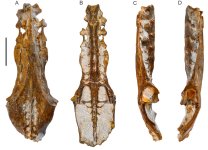Fred Ruhe
Well-known member

Jorge I. Noriega, Marcos Cenizo, Diego Brandoni, Leandro M. Perez, David E. Tineo, Juan M. Diederle & Paula Bona, 2023
,
A new pelican (Aves: Pelecanidae) from the Upper Miocene of Argentina: new clues about the origin of the New World lineages
Journal of Vertebrate Paleontology, 0 (0): e2202702.
doi:10.1080/02724634.2023.2202702. ISSN 0272-4634
ABSTRACT: https://www.tandfonline.com/doi/abs/10.1080/02724634.2023.2202702?journalCode=ujvp20
Pelecanus paranensis sp. nov., a new pelican (Aves, Pelecanidae) from the marine Upper Miocene Paraná Formation, which crops out in the Province of Entre Ríos, Argentina, is described. This record constitutes the first report of a fossil pelican from Argentina and the southernmost from South America. The holotypical specimen consists of a very large and nearly complete pelvis, which is characterized by having the cristae iliacae dorsales continuous throughout its entire length and a large foramen acetabuli. The U-shaped morphology of the postacetabular section of the pelvis of the new species as well as the wide incisura sutura iliosynsacralis, allow to infer its phylogenetic position within the New World pelican species clade, showing a close relationship with the clade (P. occidentalis + P. thagus). A probable trans-Atlantic dispersal route for the ancestor of the New World pelicans is thus inferred. The inland Paranaense Sea, which flooded the South American Chaco-Paraná basin during the mid-Neogene, is proposed as a south-north pathway for ancestral forms of the clade (P. occidentalis + P. thagus). These regressive marine paleoenvironments of the Late Miocene may have acted as the evolutionary driver for the transition of pelican species from brackish or freshwater habitats to those inhabiting strictly marine coastlines.
Enjoy,
Fred
,
A new pelican (Aves: Pelecanidae) from the Upper Miocene of Argentina: new clues about the origin of the New World lineages
Journal of Vertebrate Paleontology, 0 (0): e2202702.
doi:10.1080/02724634.2023.2202702. ISSN 0272-4634
ABSTRACT: https://www.tandfonline.com/doi/abs/10.1080/02724634.2023.2202702?journalCode=ujvp20
Pelecanus paranensis sp. nov., a new pelican (Aves, Pelecanidae) from the marine Upper Miocene Paraná Formation, which crops out in the Province of Entre Ríos, Argentina, is described. This record constitutes the first report of a fossil pelican from Argentina and the southernmost from South America. The holotypical specimen consists of a very large and nearly complete pelvis, which is characterized by having the cristae iliacae dorsales continuous throughout its entire length and a large foramen acetabuli. The U-shaped morphology of the postacetabular section of the pelvis of the new species as well as the wide incisura sutura iliosynsacralis, allow to infer its phylogenetic position within the New World pelican species clade, showing a close relationship with the clade (P. occidentalis + P. thagus). A probable trans-Atlantic dispersal route for the ancestor of the New World pelicans is thus inferred. The inland Paranaense Sea, which flooded the South American Chaco-Paraná basin during the mid-Neogene, is proposed as a south-north pathway for ancestral forms of the clade (P. occidentalis + P. thagus). These regressive marine paleoenvironments of the Late Miocene may have acted as the evolutionary driver for the transition of pelican species from brackish or freshwater habitats to those inhabiting strictly marine coastlines.
Enjoy,
Fred




